Speaking from experience, building big and defined arms can be a complete nightmare for skinny beginners. This post shares 6 mistakes to avoid to ensure success in growing arm muscle (and what to do instead).
Building bigger arms requires resistance training and good nutrition. Aim to target the arms with 10-15 sets in the 8-15 rep range, train multiple times per week, and lift a sufficient amount of weight. Additionally, consume enough calories and protein to fuel muscle growth.
By following my tips, you can set yourself for success in building those guns. The last tip is essential!

1) Work All Muscles In The Arms

The arm comprises many muscles that each need to be targeted with different exercises.
Your arms aren’t just the biceps and triceps. They comprise a variety of muscles that each need targeting with different movements for the fastest growth.
Not knowing this is a fundamental mistake that beginners commonly make. It’s a mistake that may explain why your arm muscle just isn’t growing and why many people find the arms one of the hardest muscles to grow.
You don’t need much more than 5-8 different exercises to hit each muscle and increase arm size. But the exercises should be strategically chosen for maximum efficiency.
Below are the muscles you need to be training as a skinny dude trying to grow your arm muscles:
A) Biceps
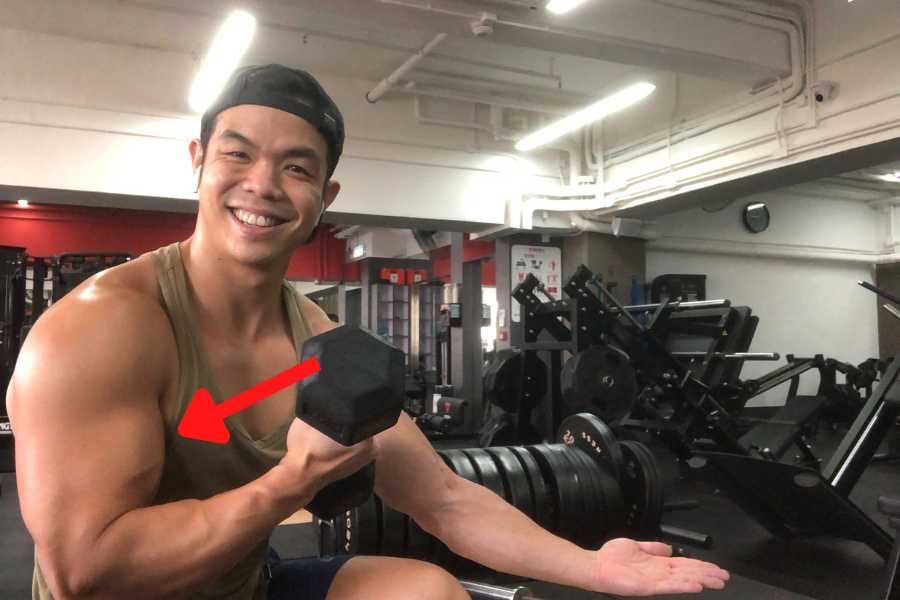
Everyone knows the biceps. It is one of the most famous muscles out there! But the bicep “bulge” is actually composed of 2 major muscles– the biceps brachii and the brachialis.
Additionally, the biceps brachii further consists of a long head and a short head. Combined, these form the main peak of your bicep bulge.
Next, the brachialis lies beneath the biceps brachii. And a larger brachialis muscle helps to fill out your overall bicep volume.
Finally, the brachioradialis is found in the upper forearm and completes an aesthetically-pleasing arm.
If you’re struggling to grow your guns, then you may want to check out my complete Skinny Guy’s complete guide to building bigger biceps.
B) Triceps
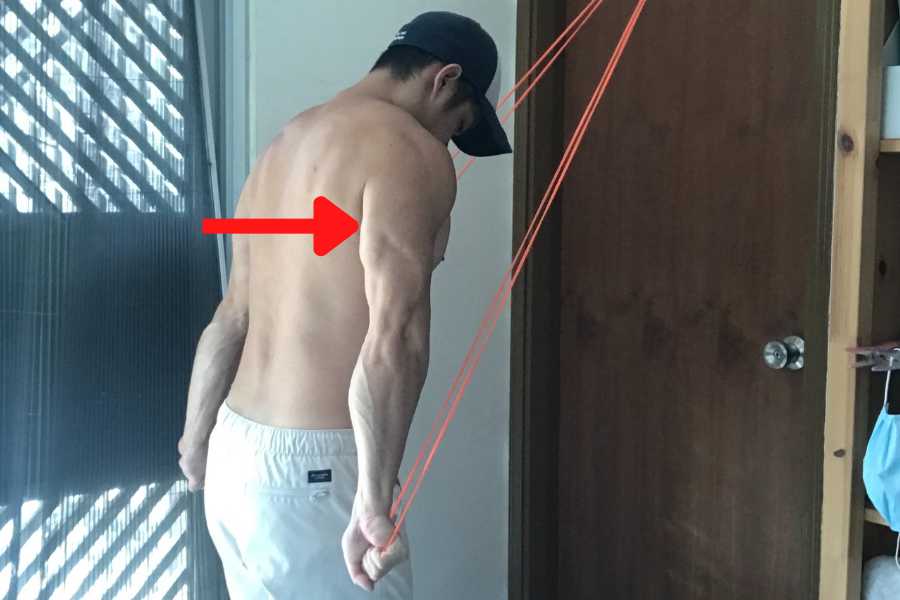
3 smaller muscles make up the larger tricep muscle– the medial head, lateral head, and long head.
All three heads come together to form what most people call the triceps.
Additionally, the triceps make up approximately two-thirds of the muscle mass in the upper arm
So make sure you give your triceps some attention if you want to grow bigger arms that fill out your shirt sleeve!
C) Deltoids
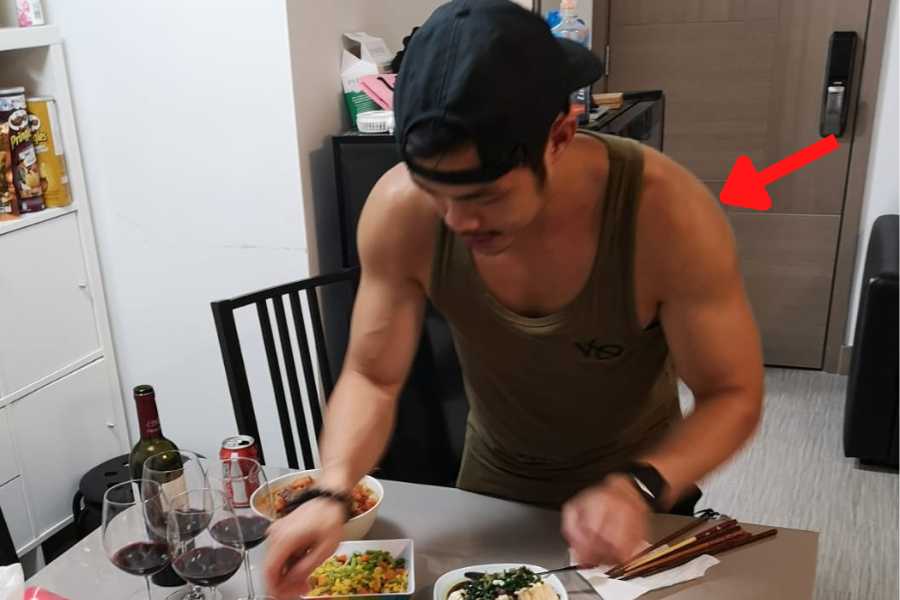
The “delts” are traditionally classified as shoulder muscles. But they insert into the upper-most region of your arms.
Thus, strong shoulders help to give the visual impression of larger arms (especially the anterior and lateral delts).
3 main muscles make up the deltoid– the anterior (front shoulder), lateral (side), and posterior (rear).
Takehome message?
People interested in growing arm muscle should not neglect the shoulders!
4) Choose Arm Exercises Carefully For Optimal Growth
Extending from the previous point- a well-chosen variety of exercises is your best bet at growing arm muscle fast.
If you don’t choose the correct movements, then certain arm muscles may not receive sufficient stimulation, resulting in poor growth.
The converse is also true- including a variety of exercises ensures you hit all the different arm muscles resulting in an overall bigger arm.
Generally speaking, I recommend 3-4 different movements for the biceps and triceps (each) and around 2 exercises for the delts.
Below, are my favorite exercises to ensure all of your arm muscles are engaged for growth:
| Biceps Exercises | Triceps Exercises | Deltoid Exercises |
|---|---|---|
| Dumbbell curl | Tricep extension | High-pull |
| Reverse dumbbell curl | Skullcrusher | Lateral raise |
| Chin-up | Tricep dip | |
| Row | Bench and overhead press |
And here’s how to do them:
A) Bicep Curls

This is the staple classic to grow biceps.
Bicep curls can be performed with free weights, machines, and resistance bands. They will target the biceps brachii as well as the brachialis.
Choosing the right weight is key for effective curling. Your dumbbells should be heavy enough to challenge the biceps but also light enough to maintain your form.
You can go to my other post to learn about the correct weight for bicep curling.
B) Reverse Bicep Curls
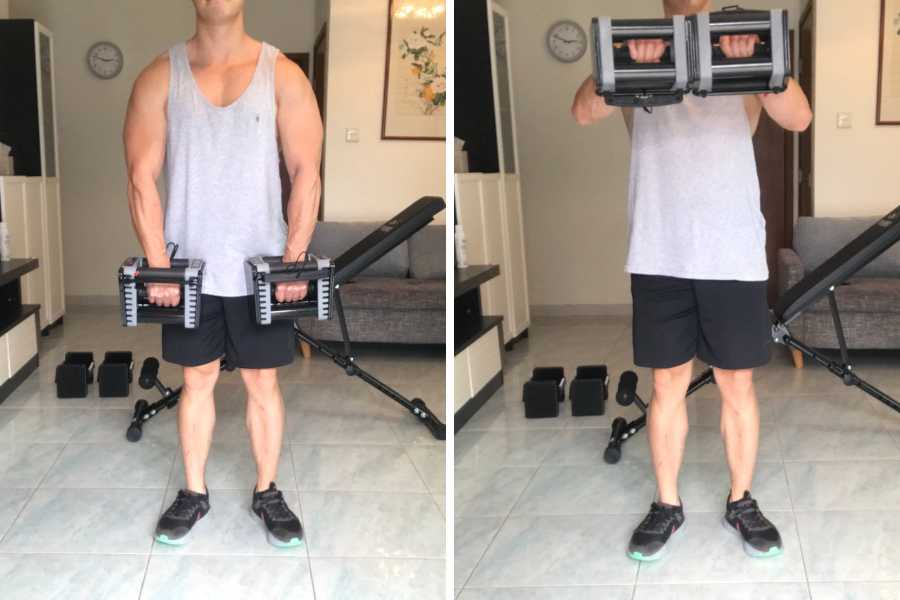
This is a great exercise to complement the conventional bicep curl for growing forearm muscle.
The overhand nature of this exercise shifts the emphasis onto the brachioradialis in the forearm.
Just like with all curl variations, the reverse bicep curl can be performed using free weights, machines, and resistance bands.
C) Chin Ups

The chin-up is a great compound bodyweight exercise. You will need a pull-up bar to perform this exercise safely though.
If the chin-up is too challenging, assisted chin-up machines can be found in most gyms! Alternatively, you can use pull-up bands to provide assistance.
Compound pulling exercises such as the chin-up are a great way to work all of the bicep muscles to facilitate growing your arm.
D) Rows

The row is another great compound exercise for growing the arm muscles.
It can be performed with free weights, machines, or resistance bands.
The major difference between the chin-up and the row, in terms of muscle growth, is that the chin-up provides a greater range of motion.
If you think about it, your arm is fully extended when you are hanging from the bar. In comparison, the arm has a degree of flexion in the starting row position.
This means the chin-up provides a more challenging stimulus for the bicep.
However, the row can be an easier exercise for beginner skinny dudes!
Make sure you choose the right weight for maximum biceps stimulation. You can check out my dumbbell row standards for more details!
E) Tricep Extensions

The tricep extension is an isolation exercise that will sculpt definition into your triceps and contribute to growing overall arm muscle.
This movement will hit all three heads of the triceps!
It can be performed with free weights, machines, and resistance bands. I personally feel that the free weight variation is less beginner friendly, as it requires balance and coordination to lift a dumbbell awkwardly over the head.
If you are a beginner who is interested in tricep extensions, I would instead recommend doing them on a machine or with resistance bands first. Then you can move on to the free weights.
As always, choosing the correct lifting weight is important. You can check out my other post for a list of dumbbell tricep extension weight standards.
F) Dumbbell Pull Over

The pullover is a compound-type lift that is great for growing arm muscle mass.
They are also great for a skinny dude trying to simultaneously get a bigger chest and lats.
It is most commonly performed using free weights, but you can also use resistance bands.
Pullovers offer a completely different kind of resistance to the triceps.
This is because they force your triceps to work isometrically (meaning the muscle contracts but does not shorten), and this is a great way to present a new stimulus to your triceps.
G) Tricep Dips

Tricep dips are a popular bodyweight compound lift for growing arm muscle, working all three heads of the triceps
If you don’t have access to a dip station, you can always use a chair (or any stable elevated surface) at home. Furthermore, you can add weights to make the dip even more challenging.
I personally love dips. They are convenient to perform, and they offer numerous options for progression (tie a 5 kg weight to your waist to really push the triceps!)
To find out how much weight you should add to your dips, you can check out my dip weight standards.
H) Bench Press

The bench press is an awesome compound exercise that should be in any skinny guys’ training program.
There are many bench press variations, all of which will help you to grow your arms (and chest!).
All bench press variations can be performed with free weights, machines, resistance bands, and bodyweight (the bodyweight equivalent of a bench press would be the pushup).
My favorite bench press to grow the arms is definitely the narrow-grip bench press (or narrow hand push-up).
A narrower grip will focus the majority of the weight onto your triceps, rather than the chest.
Additionally, you can change to a hammer grip press with dumbbells to really hit the triceps!
Both the narrow-grip bench press and hammer grip dumbbell press will effectively engage the triceps.
You can check out my other post to find out how much weight to dumbbell press.
I) Overhead Press

The overhead press is similar to the bench press, but the arms move upwards (parallel to the torso). In comparison, the bench press moves the arms outward (perpendicular to the torso).
The upward movement of the overhead press makes it excellent for engaging the anterior and lateral deltoids as well as the triceps.
This exercise can be performed with free weights, machines, resistance bands, and body weight (handstand press up).
I love this exercise! It’s a great way to build arm muscle and develop an overall more powerful upper body.
You can check out my other post to find out how much weight to shoulder press.
J) High Pulls
High pulls are basically an upright row. They are also a compound pulling exercise, making them a great way to build your biceps.
This exercise can be performed using free weights, machines, and resistance bands.
High pulls aren’t my go-to exercise to build arm muscle. That being said, they are a great compound move for building the upper body in general.
This is because they will activate the biceps, forearm, deltoids, AND back muscles.
K) Lateral Raise
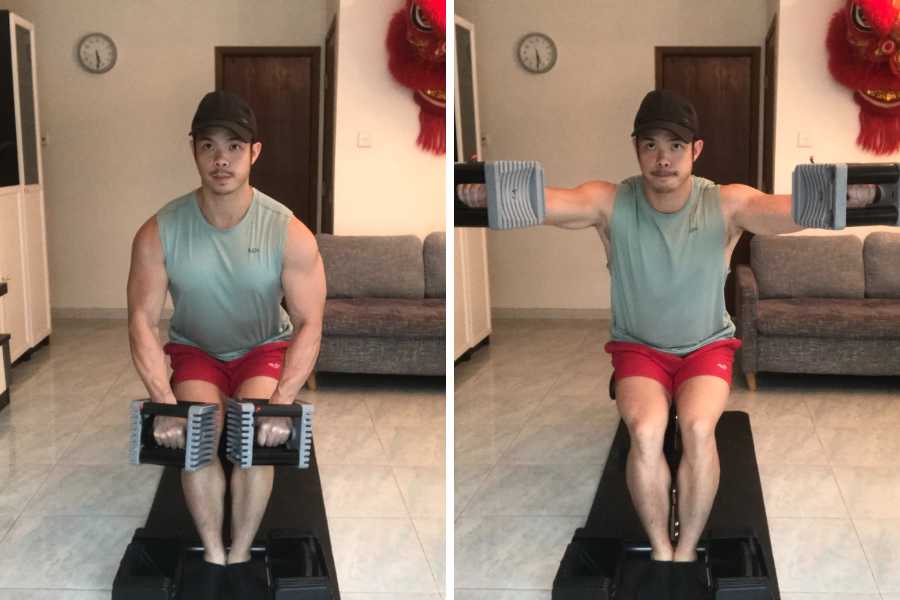
Lateral raises are an isolation exercise which is an awesome way to add definition to your shoulders. This will help to also make your arms look bigger.
They can be performed with free weights, machines, and resistance bands.
Lateral raises are amazing because they primarily work the lateral deltoids. And since the lateral deltoids join onto the upper arm, they will help to make the arm look bigger overall.
You can check out my other post to find out the ideal lateral raise weight.
2) Apply The Correct Training Volume To The Arms
When I first began working out, my sole mission was to get bigger arms. I was ready. My mind was pumped. I did my 100 bicep curls every week!
Nevertheless, my attempts were futile. My arms just would not grow.
In retrospect, I now realize they remained skinny because I simply wasn’t reaching a sufficient training volume for hypertrophy (growth).
Here’s how to ensure you do not make the same mistake that I made:
- Optimise sets and reps. Aim to hit your biceps and triceps with 10-15 total sets per week (each) as a beginner. Work in moderate to high rep range of 8-15 reps per set. For more details, you can check out my other post on optimizing biceps training volume (the same principles can be applied to triceps).
- Choose the right weight. I’ve already shared links for weight standards in many of the arm exercises detailed in the previous section. Generally speaking, you should be lifting at least 50% of your 1RM (depending on your rep range). An easy way to tell you’re lifting the right weight is if your working sets feel challenging and you can still maintain good form on each rep.
- Train multiple times per week. This is key to growing arm muscle! Optimal hypertrophy occurs when the target muscle is trained over a high frequency. Put simply, this means spreading your weekly sets over multiple workout days rather than cramming them all into a single workout. You don’t need to train your arms every day. 3 workouts per week are ideal. But make sure they aren’t performed 2 days in a row. 1 rest day between workouts is recommended for arm recovery.
6) Allow The Arms Sufficient Rest Between Workouts
Extending from the previous point, undertraining is a common mistake people make when trying to build arm muscle.
But over-training is just as bad. If you don’t allow your arm muscle time to recuperate, they will not grow.
Here are 3 tips to make sure you are giving your body the rest it requires to grow those arm muscles:
- Rest for 2-3 minutes between sets. Some trained bodybuilders advocate for inter-set rest times as short as 1 minute. But as a beginner, I recommend 2-3 mins (or however long you need to feel fully ready for the next set). Why? Intense sets are what drives growth. And you should be ready to push your arm muscles to maximum capacity with each set.
- Rest for 1 to 2 days between workouts. Avoid working your arms every day. Less is often more with building muscle. Your muscles need to rest between workouts to recover, repair, and get stronger for the next workout. I would recommend beginners rest for 2 days between intense workouts. And as your muscles adapt to training, you can reduce to a 1 day’s rest. You will know the right time to make the transition from a 2 to 1-day rest because your muscles will feel less sore and ready for another arm pump!
- Get 7-8 hours of sleep per night. This is when your body initiates most of the repair and recovery process. Sleep is essential for muscle growth!
3) Include A Variety Of Training Methods

Don’t get me wrong, training your arms with one specific type of equipment- for example, dumbbells, barbells, bands, machines, or body weight- can be effective.
But to get muscular arms quickly, I recommend working with multiple types of equipment since they each provide a different type of resistance, as follows:
- Free weights. These include barbells, dumbbells, and kettlebells. They provide very little in terms of assistance and can be loaded heavily. This makes them ideal for outright arm-building and strength gains. Additionally, the unstable nature of free weights also works all of the stabilizer muscles in your arm. And this is great for building stronger and bigger arms fast.
- Cable machines. These are found in commercial gyms. Together with free weights, they are one of the fastest ways to grow arm muscle. The advantage of using a machine over free weights is that the machines provide constant tension throughout the range of movement, unlike in a bicep curl (for example), where tension decreases as the dumbbell approaches the top of the curl.
- Resistance bands. These are cheap and effective type of equipment that complements free weights very well. The difference between bands and weights is mainly the resistance profile. Unlike weights, bands generate increasing resistance as they stretch. This can provide a completely new stimulus for your arm muscle to adapt to and keep it growing. It’s great for slow and controlled arm curls/extensions to really get the blood flowing into your biceps/triceps.
I personally love using weights as my primary training method to build size and strength and supplement this with band exercises to get a great pump on my arms.
5) Eat Muscle-Building Foods To Grow The Arms
This is a big one.
In my opinion, THE biggest mistake that prevents skinny people from growing arm muscle- poor nutrition.
You can be following the best arm workout in the world. But if you’re not fuelling the hypertrophy (growth) process, then your arms just won’t grow.
Nutrition to grow bigger arms fast:
| Nutrition | Recommended Intake | Role |
|---|---|---|
| Calories | 5-15% surplus for a lean bulk | Energy for workouts, recovery, and hypertrophy. |
| Protein | 1g per lb of body weight | Raw material for muscle growth. |
| Carbs | 2.5g per lb of body weight | Energy for workouts and recovery. |
| Fats | 0.4g per lb of body weight | Energy and hormone production. |
Calories and protein are the most important to track. These two nutrition intakes can make or break your arm-building success.
You can check out my other post for more details on how to bulk as a skinny guy.
Here’s a list of high-protein foods to build bigger arms:
- Lean beef.
- Pork.
- Chicken breast and thigh.
- Tinned tuna.
- Salmon.
- Mackerel.
- Nuts and seeds.
- Beans.
- Tofu.
- Soy milk.
Carbs and fats are less essential to track. As long as you’re eating sufficient calories, you can build muscle.
Conclusion
The most common mistakes people make that prevent them from successfully growing arm muscle boils down to training volume and nutrition.
Make sure you complete enough weekly sets, reps, and workouts to maximize bicep/tricep stimulation. Use a variety of exercises to hit all muscles in your arms (make sure the weights are heavy enough). Ensure sufficient rest for optimal muscle growth.
And most importantly, eat a good bulking diet to make sure that all of the hard work you do training ACTUALLY grows your arms!
You may also be interested in the downloadable Kalibre Blueprint PDF which details exactly how I gained 40lbs of lean muscle (it’s 100% free!). It details the exact exercises and nutrition (with printables) I used to go from skinny to ripped!


